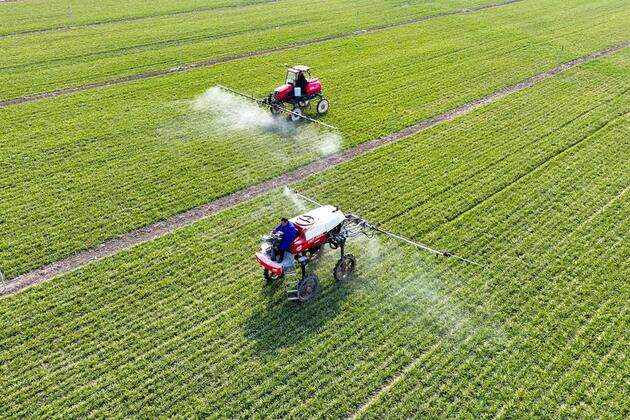Agriculture blossoms with tech innovation drive
Xinhua
26 Feb 2025, 22:37 GMT+10

BEIJING, Feb. 26 (Xinhua) -- From drones monitoring crop growth to automated irrigation systems, China is reshaping its agriculture with technological innovations that help ensure the country's food security and lay the groundwork for rural revitalization.
In the recently released "No. 1 Central Document" for 2025, Chinese policymakers have, for the first time, identified the development of "new quality productive forces in agriculture" as a top priority. The document underscores the need to increase support for smart agriculture and calls for expanding the use of technologies such as artificial intelligence (AI), big data, and low-altitude systems in agricultural production.
As the spring plowing gathers momentum across the country, various localities are harnessing cutting-edge technologies to improve the efficiency and diversity of the food supply, aligning with the strategic initiatives outlined in the document.
SMARTER FIELDS, HIGHER YIELDS
The central province of Henan is China's leading wheat producer, contributing nearly a quarter of the country's total wheat output. However, the region's grain production has historically been prone to natural disasters such as droughts and floods.
For Lou Junjie, a farmer from Xinxiang City, the challenges posed by nature were all too familiar. However, technological innovations have made his wheat cultivation more secure, making weather changes more predictable and manageable.
"I regularly receive updates on weather conditions, soil health and crop growth," said Lou, gesturing toward traffic light-like devices scattered across his wheat fields. "They are really helpful, letting me know exactly when to plant, water or harvest my wheat."
The devices are monitoring poles equipped with high-definition cameras, weather sensors, insect traps, and soil sensors. They constantly collect data related to grain growth and send it to a smart analytics system, which processes the data and provides timely guidance for farmers.
The intelligent system is one of the latest outcomes of Henan's "Central-China Agricultural Valley" project. The project employs monitoring stations and satellites to gather and analyze data, focusing on science and innovation in seed breeding, smart agriculture, and high-quality farmland cultivation.
Henan's local practices epitomize a broader national trend. In November 2024, the Ministry of Agriculture and Rural Affairs unveiled a blueprint for sci-tech innovation in the agriculture industry. The blueprint emphasizes integrating information technologies, such as the Internet of Things, big data and AI, with mechanical farm equipment to accelerate the country's agricultural modernization.
Feeding a population of 1.4 billion, China's grain output reached a record high of 706.5 million tonnes in 2024, marking the first time the country has achieved a grain harvest exceeding 700 million tonnes.
"China is holding firmly onto its 'rice bowl,' and behind this, agricultural technology is playing an increasingly important role," said Song Lili, a researcher with the Chinese Academy of Agricultural Sciences. "Given the country's limited arable land, technological innovation has become a crucial factor in ensuring stable and high grain production," Song said.
According to official data, technology contributed over 60 percent to China's agricultural growth in 2023, marking an increase of 10 percentage points from 2012.
Science and technology are now integral to every aspect of farm production, from plowing and planting to fertilizing and harvesting, serving as a key driving force in stabilizing crop yields, Song said. "Chinese people have achieved a historic transformation from scarcity to abundance and are now striving to eat well, nutritiously, and healthily."
TECH BRINGS MORE TO THE MENU
With a vast population to feed, China is actively diversifying its food supply to ensure food security. As agricultural technology thrives, people are enjoying a wider variety of food choices than ever before.
A fresh delicacy beloved worldwide, salmon is not widely cultivated in China due to the fish's preference for cold water habitats. However, a technological breakthrough has made domestically-raised salmon more frequently seen on Chinese restaurant menus.
About 130 nautical miles off the coast of Qingdao, a city in east China's Shandong Province, a giant aquaculture cage floats on the vast blue sea. Dubbed "Deep Blue No. 2," the cage houses a large school of salmon destined for markets in inland regions.
In the summer, Deep Blue No. 2 can descend deep beneath the sea surface until the water temperature drops to a range of 10 to 16 degrees Celsius, which is ideal for salmon cultivation, according to Gu Qihuan, manager of a local marine technology firm. "And when winter arrives, it will ascend back to the surface."
Measuring roughly 70 meters in height and diameter, China independently developed the cage. It has an automated feeding system and an underwater imaging system, marking a milestone in the country's efforts to breed cold-water aquaculture in warm waters.
With the help of such cutting-edge facilities, efforts to diversify the food supply system are steadily advancing. The increased availability of high-quality food ensures that China's population has enough to eat and meets the growing desire for better, more enjoyable meals, contributing to an improved quality of life.
Building on the momentum, the State Council, or China's cabinet, has released a guideline to create a diverse food supply system. The directive aims to develop new food varieties, sectors and technologies to balance supply and demand and ensure national food security. Notably, it highlights the need for technological innovation to improve food production quality and efficiency and calls for stronger basic research for food technology innovation.
At a recent press conference, while commenting on the outlook of China's agricultural development, Han Wenxiu, executive deputy director of the Office of the Central Committee for Financial and Economic Affairs, emphasized the urgency of increasing grain output to ensure bumper harvests amid growing uncertainties from extreme weather and natural disasters.
"Overall, China's food supply is not exceeding demand; rather, it remains in a delicate balance," Han said. According to an action plan published by the State Council last year, the country aims to boost the grain production capacity by over 50 million tonnes by 2030.
 Share
Share
 Tweet
Tweet
 Share
Share
 Flip
Flip
 Email
Email
Watch latest videos
Subscribe and Follow
Get a daily dose of Japan Herald news through our daily email, its complimentary and keeps you fully up to date with world and business news as well.
News RELEASES
Publish news of your business, community or sports group, personnel appointments, major event and more by submitting a news release to Japan Herald.
More InformationAsia Pacific
SectionFoxconn seeks Honda as a partner, eyes ties with Nissan, Mitsubishi
TOKYO, Japan: Foxconn has approached Honda Motor with a proposal to form a partnership, aiming to establish a broader collaboration...
NSW Man Faces Perth Court Over $1.1 Million Cash Seizure
PERTH, Western Australia - A 21‐year‐old Sydney, New South Wales man is set to appear in Perth Magistrates Court on Saturday after...
Taiwan defends Strait’s status after China criticizes Canada
TAIPEI/BEIJING: Taiwan's defense ministry said this week that the Taiwan Strait does not belong to China, and any attempts to create...
Update: In China's Harbin, world's largest ice-and-snow park concludes with record-breaking tourist visits
An aerial drone photo taken on Feb. 25, 2025 shows tourists visiting the Harbin Ice-Snow World in Harbin, northeast China's Heilongjiang...
China's first wholly foreign-owned tertiary general hospital opens in Tianjin
A medical worker walks by a billboard for the opening ceremony of the Perennial General Hospital Tianjin in north China's Tianjin Municipality,...
Agriculture blossoms with tech innovation drive
An aerial drone photo taken on Feb. 18, 2025 shows farmers operating agricultural machines to carry out field management in Qiaocheng...
Business
SectionFlorida claims Target ‘misled investors’ with its DEI initiatives
TALLAHASSEE, Florida: Florida's new attorney general, James Uthmeier, filed a federal lawsuit against Target this week, claiming the...
Foxconn seeks Honda as a partner, eyes ties with Nissan, Mitsubishi
TOKYO, Japan: Foxconn has approached Honda Motor with a proposal to form a partnership, aiming to establish a broader collaboration...
Consumer Confidence Survey weighs on Wall Street
NEW YORK, New York - There was a mix of gains and losses in the United States on Tuesday with tech stocks selling off, and industrials...
Audi plans North America expansion with location expected this year
BERLIN, Germany: Audi is moving forward with plans to expand production in North America, and CEO Gernot Doellner said a decision on...
Reuters survey: Bank of Japan likely to hike rates to 0.75% in Q3
TOKYO, Japan: The Bank of Japan is expected to raise interest rates at least once more this year, likely in the third quarter, bringing...
Nasdaq Composite plummets 237 points as U.S. investors fret
NEW YORK, New York - U.S. stock markets closed lower on Monday, with the major indexes showing mixed performances as investors digested...












